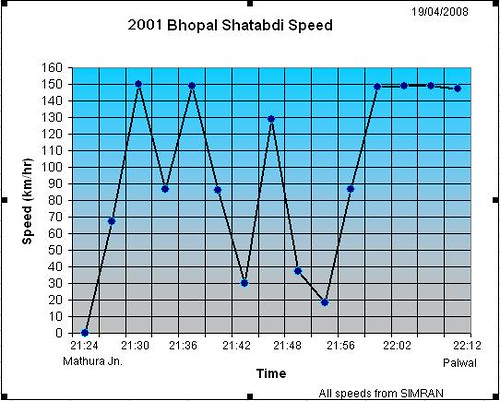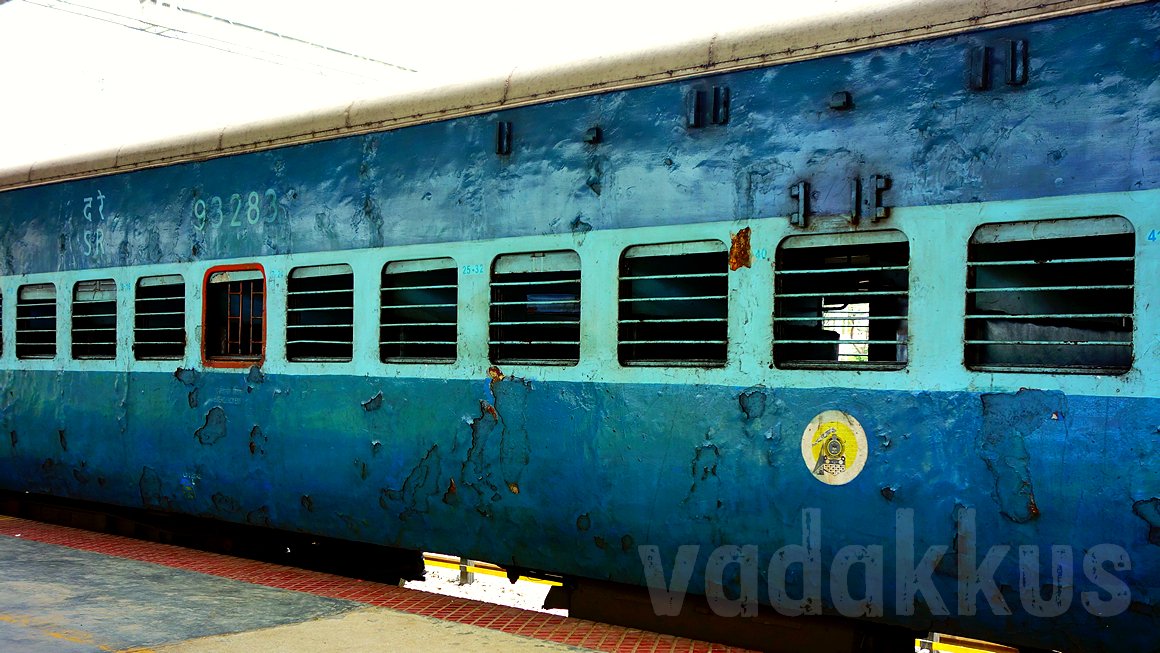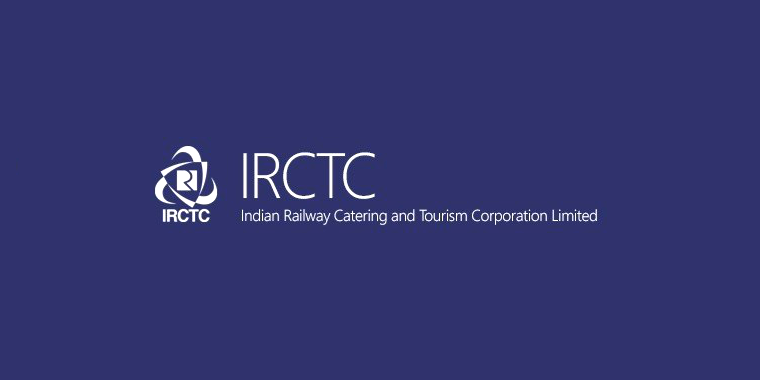Why Are Indian Railways Trains So Slow?

[dropcap]The[/dropcap] Indian Railways is totally awesome when it comes to scale, coordination, operations and locomotives, no two doubts about that. But when it comes to speed, quality of service, aesthetics and looks, our railways are still stuck in the 19th century with its clunky metal rattletraps of coaches and stinking toilets. But the Achilles Heel of our trains remains speed. Our people spend days traveling epic distances on “express” trains, trains that run at average speeds of 45 kph and 37 kph, save for some elite trains on selected stretches.We are a long, long way away from global standards when a train with average speeds of 55 kph is considered “Superfast” and 70 kph is “premium!” But why are Indian trains so slow? Why is it that despite having the fourth largest railway system in the world (third largest in terms of passenger services) our trains still take forever to complete their journeys and creak, groan and rattle and clatter to their destinations, sometimes hours late? When presented with the question on how to speed up Indian trains, most people will jump to suggest to increase top speeds of our trains. However, it is not that simple. Increasing top speeds will do no good in our present scenario which I will explain below.
The Question of Top Speed
First off, the average speed or the time taken by a train to cover its distance is not a factor of its top speed. The speed of a train is directly dependent on only two things: The track and the rake (coaches) that constitute the train. In western countries which use trainsets of different capabilities for different types of service (TGV trainsets for highspeed, Bombardier ETRs for Intercity, Alstom Coradia for Commuter etc), the question makes sense. In India, the same types of coaches and locomotives are used to run everything from a Rajdhani to a local Passenger train, the question of “top speed” itself is irrelevant. All trains, be it a Rajdhani or a Passenger are allowed achieve the same “top speeds” irrespective of the service they run, depending on what the Maximum Permissible Speed (MPS) of track section is. The only thing that holds a passenger from running at 110 kph for long periods is the number of stops it has, there are no “top speed limits” imposed on them.
Indian trains are not really “slow” if you take the actual physical speeds at which they run. Current top speeds of Indian Railways trains are 110-120 kph for most (old style) ICF coaches and 130-140 kph for AC LHB trains on most important trunk lines, and we have locomotives capable of hitting 160 kph, all of which are actually quite good for everyday non-bullet train setups. It is not the top speeds of our trains that are low, but the average speeds. The Purushottam Express for instance is allowed a top speed of 130 kph with its LHB rake and all, but has an average speed of only 60 kph. If you were to consider top speeds alone our trains are doing quite well. In fact, it will come quite as a shock to many when I say that speeds of Indian trains compare favorably with those of the best in the world in its class, like those in Japan.
Honestly, if our trains looked like this, I wouldn’t mind even if they ran late by 2 hours everyday.
Not all trains in Japan are “Bullet Trains” running at 320 kph, they have “ordinary” express trains too. One such, JR East’s Super Hitachi Express (above) takes 2 hours and 16 minutes to cover the 210 kilometers of its end-to-end run between Iwaki and Ueno-Tokyo on the Joban line at an average speed of 92 kph and maximum operational speed of 130 kph with 13 stops. This is exactly the same distance between New Delhi and Agra which the Bhopal Shatabdi covers in exactly the same duration at exactly the same average and top speeds, but without stops. However, other than 6 premium trains all others on this section have average speeds of below 75 kph and most around 55 kph, on the same high-speed line the Shatabdi runs on. Why can’t other trains match the Bhopal Shatabdi’s speeds, which can match the Hitachi Super Express in speed? Shouldn’t the Purushottam Express have average speeds of like, 85 kph atleast? If top speeds are not the problem, what is? This chapter tries to answer these questions.
Reasons for why Indian Railways trains are slow overall
The average slowness of Indian trains is not really the problem but a symptom and effect caused by the real problem. Indian trains are “slow” on an average due to their inability to maintain top speeds uninterrupted over long periods of time. Look at the speed chart of the Bhopal – NDLS Shatabdi for a particular run. Ideally it’s run should be more or less at constant speeds like that of the last 10 minutes.

While traveling in trains in India you would’ve noticed that they almost never exhibit constant speeds. A train might sprint at 110 kph for 30 minutes only to stop somewhere for 20 minutes and then crawl at 30 kph for 10 minutes before picking up speed again. Repeat this in no particular sequence for the entire journey. Even when you might think there should be something wrong with your train being stranded at some half-platform station or on the track for 30 minutes for no apparent reason, even on double lines, this is absolutely normal as far as Indian Railways is concerned. This is the symptom of some endemic problems.
The real problem that plagues the Indian Railways are also the causes of our trains taking too much time to cover their distances are mainly these two:
- Unavailability of enough tracks for all trains to run, leading to frequent overtakes and stoppages
- Weak tracks that require constant maintenance resulting in low top speeds and speed restrictions
The first one is the more severe problem. Let us look at these and more:
Too Much Train and Too Little Track
Indian Railways’ problems are analogous to its roadway counterparts. Just like our (inadequate) roads are jammed with vehicles, our rail tracks are also literally jammed with trains. The biggest problem Indian Railways face is that there are way too many trains and way too less tracks for them to run on. In India, for every available track kilometer a train runs 55 km on an average every day. Normal trains cannot run uninterrupted for extended periods of time at their top speeds because eventually have to stop to let other trains run too, creating scheduling problems causing trains remain stranded at stations or tracks for long times. But this should not be true for double lines, right? Contrary to popular belief, scheduling woes do not end when a single line is made double track because even then unlimited number of trains cannot be run on them. High-speed Shatabdis and Rajdhanis, 24-coach long-haul expresses, local MEMUs, commuter expresses and ultra-heavy freights all running at different speeds with varying number of stops have to use the same set of tracks to run, resulting in bottlenecks as faster trains get stuck behind slower ones and in turn the slower ones have to stop and wait at stations for faster ones to go past them and so on (watch the video below). It gets more complicated when it comes to lines which have many other lines joining and leaving it. And let us not even talk about single-line sections.
The Pune-Secunderabad Shatabdi crosses the SBC-CSTM Udyan Express and (left) and overtakes the CSTM-MAS Mail (on the SUR-GR single line). And both these trains will have this “time loss” worked into their timetables.
If there were multiple lines (four, for example) everywhere, slow and fast trains would’ve gotten dedicated lines to run without interfering with each other which would allow trains to run at higher speeds for longer periods. This unavailability of track is the main reason why trains have low average speeds in India because all that time required for overtakes, crossings, crawling behind etc need to be factored into while preparing the timetable by the allocation of inordinately long time periods for trains to cover some stretches, resulting in low average “speeds” on paper which get translated into real life. Imagine if a new double line were to be laid between Delhi and Allahabad dedicated for fast express trains, they would cover distances in much lesser time having nothing to interrupt their run like freights and passenger/local trains, thereby raising their average speeds in the timetable.
Trains running in India are regulated and controlled by operators known as “section controllers”. They sit behind large screens showing train movements on their sections of around 150 km and work with station masters to regulate train running on a day-to-day basis, mostly like Air Traffic Controllers. As all types of trains have to use limited tracks, congestion ensues and it is left to these controllers to sort out the mess. To do this, they work out a system on how the trains are to be run, partly in accordance to a “Working Timetable” and set rules and partly according to best practices and commonsense. They control and set all signals along the tracks and using them control the trains, making some trains to wait at some stations or tracks while allowing others to go ahead or making some others crawl behind others and so on in a kind of bizarre board game, only much more complicated.
Scenario: An Express is stopped at a signal 8 km ahead of station ABC on a double-track line because a passenger train is occupying the line ahead of it. It is allowed to move only after the Passenger had arrived at station ABC. The Express then reaches ABC after 10 min, by which time the passenger had left. It has a two minute scheduled halt at ABC stops there for 15 min while a Superfast which does not stop at ABC barrels past it (overtake). The express starts after another 5 min and overtakes the passenger after two stations which was already overtaken by the Superfast at the same station (extending the stop of the passenger at that station to 20 min). Then after four stations the Superfast and after three stations the Express both are made to stop for 10 minutes each while a Rajdhani blasts past. After 50 km the Rajdhani is then stopped outside a station for 5 min to allow a train crossing over from a branch to the mainline to reach a platform. If the branch train were to be made to wait for the Raj to pass, another already delayed train behind it (maybe a Jan Shatabdi of the controlling division) would get even more delayed. And all these time losses for overtakes are included in the timetable in the form of “slack time” (explained below). Read another such real life scenario (which I experienced) here.
If there were four lines in that section instead of two, all those overtakes could’ve happened while the trains were on the run itself without one having to stop and wait to let the other pass. That way, atleast half an hour could’ve been cut from their running time as all those lengthy stoppages could’ve been avoided and thereby increasing average running speeds of the passenger, express and Superfast.
The Mangala Express overtakes the Kochuveli – Dehradun Express at Okhla. Looking at the passengers on the platform, the WAP5 led train would’ve been stranded at the side platform for quite a long time.
The busiest corridor of the Indian Railways is the Allahabad – Kanpur – Varanasi – Mughalsarai section of the Northern Railway and North Eastern Railway spread out over Uttar Pradesh. Around 160 passenger and 240 freight trains use this stretch every day, meaning 16 trains have to pass through this section every hour or one every 3.5 minutes, leading to extreme scheduling problems of the time described above. Non-premier trains between Delhi and Bihar/Calcutta/the North East get delayed in this section by many hours every day despite it being a fully electrified double line (FEDL). This section is known as the Bermuda Triangle of the Indian Railways for good reason. This section requires 2 more tracks and a dedicated double-line freight track urgently. There are many such Bermuda Triangles on Indian Railways.
Infrastructure
Most of our tracks some mainlines included are simply not strong enough to support speeds of even 110 to 130 kph, even if the trains are. These low top speeds then affect average speeds as more time is allocated in the timetable for these sections. Trains are held up outside stations because most do not have enough platforms, outdated signaling systems with huge block sections which make one-behind-another train scheduling impossible. trains having to switch over to another line will have to wait until the traffic on the line it has to cross is clear, curved tracks, ghat sections etc all slow down trains. Points and crossing force trains to slow down to 30 or even 15 kph to switch tracks even while coming to a halt at stations. And of course, all types of varying traffic using the same tracks cause uneven wear and tear reducing ability of trains to sustain high speeds over more time. And then there is of course the thing of long-distance trains being made to stop at every other station by populist politicians and bursting-with-ego “rail activists” making trains to lose even more time.
Train Design
The design of our trains do not help either. Simply put, they are designed to be utilitarian and not to run at high speeds. Apart from being heavy and unweidly, our coaches are not really shining examples of aesthetics, save LHB coaches. Apart from open doors and windows, old-fashioned chain-and-buffer coupling and ancient ICF bogies which are just wheels connected to an axle, the monstrously inefficient single-locomotive-in-the front approach is one of the major reasons bringing average train speeds down. As the locomotive will alone have to all the driving and pulling, trains take forever to accelerate from stops and slowdowns. Almost all modern train systems in the world today use EMU trainsets for even their long distance trains which will have motors powering wheels of many coaches resulting in faster acceleration. The first major overhaul Indian Railways should commit to is ditching our train composition systems for EMU trainsets.
Speed Restrictions
Temporary (TSR) and Permanent (PSR) Speed Restrictions are the “active” culprits for both the late and overall slow running of our trains. Speed restrictions require the train to slow down to a prescribed speed (30 kph usually) while passing though that section. TSRs are erected for reasons like track damage, repair or maintenance on running or adjacent track, recent accident spots and so on for a short time period (upto 6 months). PSRs are installed for all the above plus for ghat sections, curves, points/crossings/ track switchovers, stations, animal crossings, level crossings, urban settlements, old/weakened bridges/culverts and so on on a permanent basis. Add to this caution orders and line blocks which are all more or less the same thing. These are the reason why a train running fast suddenly slows down to a crawl for around 10+ minutes before speeding up again. And this happens almost every half an hour which makes the train unable to maintain its top speed and ultimately causing a drop in its average speed. If your train keeps on crawling over tracks, speed restrictions due to weak/worked upon tracks are the reason.
Mentioned above are only major issues that make trains slow down or lose time, thereby increasing their average running time. There are a plethora of other reasons like accidents, natural calamities, fog, chain pulling, open level crossings, locomotive / coaching equipment / signaling / OHE, crew issues, strikes, waiting for VIPs, loco pilots going off to buy food and other such innumerable reasons. And while creating the timetable, the time to be taken by the train for each section is calculated by taking into consideration all these factors and not just the top speed.
The Great Railway Timetable Magic Trick
Finally, the total time (and hence the average speed) taken by a train is the sum total of all the time it takes to traverse all of its sections. In a perfect world, the average speed would be closely related to the top speed as that will be base on which the time is calculated. But not in India. As shown above, there are a plethora of other factors to be considered like other trains running on the line and joining/leaving it, if the track is single or double or multiple line, the rating, capacity, terrain and speed of the track, availability of locomotives, rakes, crews, maintenance facilities and platforms at stations, stoppages, population density, climatic conditions and so on in addition to everything else mentioned in this chapter so far, adverse effects of any of which can delay or cause trains to run at reduced speeds. While preparing the timetable, all these “obstructive factors” have to considered and additional time has to be allotted to “make up” time lost due to them. In short, a train spends a lot of time not running, ultimately reflecting as “low average speeds” of our trains. And this “compensatory time” to make up for delays of trains due to these factors is allotted using some special techniques in the timetable, called “Slack Time”.
The Magic of Slack Time: If you look closely at the public timetable of any train, you can notice that the time given for any train to cover the distance between its stops will be rather inconsistent, especially between the last two stops. These gaps are no aberration but a technique known as “slack time”or “margin” or “extra time allowance”. This “extra time” allowed is an adjustment technique for trains to “make up” lost time at major stations and at the end of their journey as the “late time” will be canceled out by this slack time. All these “slack timings” are meant to compensate for all the time they lose because of all the reasons above like overtakes, crossings, speed restrictions, bad tracks etc. It can be estimated that around 30% of a train timetable is slack, which means that if slack timings were eliminated our trains could automatically be speeded up by 30%! How to eliminate slack?
Examples: The Purushottam Express for example, is supposed to to clear the 72 km distance between Cuttack and Jajpur in 44 min at 98 km/hr while the same train is given 50 min to cover 15 km between Bokaro and Chandrapura! For the 12626 Kerala Express is given 35 min to cover the two kilometers between Trivandrum Pettah TVP and Trivandrum Central TVC! Another prominent slack (or make up time) given for this train is between Aluva and Ernakulam Jn, one hour allotted to cover 20 km. An Overtake example: The 16525 Island Express to Bangalore is often detained at Irinjalakuda for some 20 min for the 12082 Jan Shatabdi to overtake it, though the stipulated stoppage specified in its timetable is only one minute! It is given enough slack time everywhere to make up this loss.
The concept of slack time in itself can be taken as an acknowledgement by the railways that Indian trains are not really meant to run on time. The entire timetable is reduced to a farce, arrival/departure timings mentioned in timetables are more of arbitrary guidelines which are not really meant to be followed. Now you know why Indian trains are never on time. Ground realities in a chaotic country like India can hardly ever be adjusted into the linear, clinical and glossy worlds of timetables.

In the end, the the slow average speeds of Indian trains are the end product of a mishmash of a lot of complicated technical realities like traffic, weak and badly designed tracks and stations, speed restrictions, design of our trains, operational constraints and lots of other arbitrary things, the least of which is the top speeds of trains. Even if we were to magically raise the top speeds of our trains to 160 kph without addressing the problem of insufficient tracks and other things, nothing much would change except that trains would run at 160 kph for brief periods before being stopped to wait at wayside stations for more time.
The best way of improving average speeds and running times of our trains is not by raising speeds, but by improving running infrastructure (more, stronger tracks, platforms, bridges etc) and by modifying running laws; which will enable our trains to run at constant speeds for longer times without being stranded here and there, enabling slack time to be cut and hence overall running times to be reduced.
Back to our Super Hitachi question. All other trains are looped for the Shatabdi to blast past (it overtakes four trains each way everyday), it gets the primary slot at all stations and platforms and the best, modern coaches and locomotives. Congestion on the tracks simply does not affect it, accentuated by the fact that the Shatabdi hardly has any slack time! The only thing that can affect its run are speed restrictions and fog. As a result of all this, it is able to match or even better the Super Hitachi. But why can’t this be done for all trains in India? Simple, because of all the reasons given above. With its limited resources, India cannot afford to do a Bhopal Shatabdi for more than some 20 or 30 pairs of trains. The Super Hitachi has its own tracks to run unimpeded as the Joban Line has three or four tracks so that slower services can run without interrupting the Super.
This is Bad. How did it all Come to This?
As it is with everything, most of this mess can be put squarely on the politics of socialist populism threatening to ruin our nation. During every budget populist politicians announce sundry trains between random cities to keep masses happy without any thoughts of improving infrastructure for those trains to run. (However, hopefully this will now change with Mr.Suresh Prabhu refusing to announce any new trains in this years’ budget) Almost all problems regarding the “running” of trains in India stem from this unavailability of tracks. But how did it all come to this? How did it get so bad? Why did our railways (like everything else) never modernize? Why didn’t we ever build new tracks? Why didn’t we improve our running laws and rules? Why didn’t we never address these shortcomings preventing increase of our average train speeds all these years, despite all the improvements in technology? And also, why do our trains still look like they just landed from the 1950s? Why don’t we have all those beautiful, sleek, gleaming, glamorous flashy trains that look like some planes out of a sci-fi movie running on the ground? Again, there might direct cause-and-effect explanations for this, but that is merely scratching the surface. The forces behind those causes go much deeper, all the way back to 1947 or even before. More about that in the next part.






There are a few more, fundamental problems that reduce speeds of our trains- we have many that wander around a lot, often in massive curves. An example is the Karnataka Sampark Kranti via Hubli- the shortest route may be straight via Hyderabad, but this one wanders right, left, right again- covering a needlessly long distance. In several cases (like Mumbai-Indore), the absence of straight tracks causes trains to trace long arcs or L-shapes to reach their destinations. Then we have several tracks, mostly converted from NG/MG, which are so full of tight curves, they reduce the speed a lot. Direct lines, bypass/loop lines can ensure trains can reach their destinations a lot sooner. Land acquisition is often the excuse- but I wonder, how did the highway authorities get it done so soon? As mentioned in a later post, highways occupy so much more space across the breadth than an electrified double track.
We see EMUs as a solution for our average speed problems- but the way our services have been planned, are they feasible across the board? A 24-coach EMU to run the Paschim Express or Karnataka Express? While our passenger coaches and locomotives are now a lot better, our EMUs (particularly mainline) use obsolete motor technology- and still have propulsion/power equipment occupying 25% of the motor coach! The sooner we get superior EMU technology, the better. Even otherwise, the excessive weight pulled by our locomotives won’t crank up average speeds much- two locomotives are needed for our trains, preferably one at each end- even if it means modifying our coaches to attach two electrics.
The one challenge most high-speed rail networks don’t encounter, that our trains do, is topography. Our trains often go up and down mountains, or around several rocky surfaces. There may still be a solution, looking at how Germany tackled gradients along the Frankfurt-Cologne high-speed route- most probably involving viaducts to carry straight tracks. Ultimately, it will boil down to costs- whether they can get more out of building shorter, straighter tracks or multiplying and strengthening existing tracks and running higher quality rolling stock.